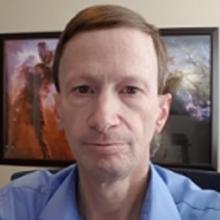
SETI Institute Affiliate
Astronomy, Astrophysics, Planetary Science, Astrobiology
Location: Beavercreek, Ohio
Education: PhD, The Open University, Milton Keynes, UK
Research Interests:
My professional astrophysics interests lie in the area of spectroscopy (stellar, galactic, quasars, ISM, IGM, and exoplanetary atmospheres). I am interested in applying the technique of derivative spectroscopy to search for very weak absorption/emission line features in spectra that would otherwise be difficult to discern (e.g. the uranium feature in the spectra of ancient stars as a chronometer metric for galaxy ages). My other major area of interest is modeling/simulating exoplanet 3-D climate patterns of hypothetical Earth-like planets based on different orbital parameters, planet obliquity and rotational period, star spectral type, surface land mass configuration, and atmospheric composition.
A secondary interest of mine lies in the field of Exoplanetary Science. I am interested in producing models of hypothetical Earth-like exoplanets using 3-D planetary climate models to create a database of models that could be used by future Exoplanetary Scientists to compare with data that will be collected by JWST and other future space-based observatories.
If a suitable grant could be obtained, I would also like to pursue research in the area of atmospheric “Technosignatures” by simulating the spectra of different anthropogenically produced gases with varying concentrations, such as chlorofluorocarbons, perfluorocarbons, and sulfur hexafluoride. These simulations could be compared with observational data acquired by various terrestrial remote sensing satellites to determine the relative and absolute abundances of these gases. It is suspected that any advanced ET civilization would make use of these types of chemicals as part of their industrial processes. Since many of these gases are trace gases with extremely weak absorption/emission features in spectra, I propose to use the concept of derivative spectroscopy to improve the signal to background ratio of spectral data. This tends to accentuate very weak features in spectra, allowing their detection when they might not be detected in the original spectral data.
NASA’s Planetary Spectrum Generator is well-suited for the simulation of planetary atmospheric spectra under different observing geometries, spectral instrument parameters, imaging system parameters, atmospheric concentrations, and noise. The PSG could be improved by adding anthropogenically produced gases to the modeling tool’s database for this researchproject.
